A mass for asymptotically complex hyperbolic manifolds
A mass for asymptotically complex hyperbolic manifolds
A mass for asymptotically complex hyperbolic manifolds
You also want an ePaper? Increase the reach of your titles
YUMPU automatically turns print PDFs into web optimized ePapers that Google loves.
hal-00429306, version 1 - 2 Nov 2009<br />
A MASS FOR ASYMPTOTICALLY COMPLEX HYPERBOLIC MANIFOLDS. 21<br />
Exactly as in the odd dimensional case, we see that the corresponding elements of<br />
N(CH m ) ∼ = Λ 2 J R2m,2 are<br />
Q c (ϕ a l−1<br />
l+1<br />
) = βϕa = − Jdxaj ∧ dxaj + Jdxăj ∧ dxăj + Jdxm+1 ∧ dxm+1,<br />
Q c (˘ϕ b ) = β ˘ϕ b = −<br />
j=1<br />
l<br />
Jdxbj ∧ dxbj +<br />
j=1<br />
j=1<br />
l<br />
Jdx˘bj ∧ dx˘bj + Jdxm+1 ∧ dxm+1,<br />
It follows that < βϕa,βφ a >=< β˘ϕ b,β ˘ϕ b >= m+1, < βϕa,ω >= 1 and < β˘ϕ b,ω >= −1.<br />
The βϕa’s +1<br />
all belong to the same orbit under the action of PU(m,1) : let N CHm be<br />
this orbit. The β ˘ϕ b’s also belong to the same orbit under the action of PU(m,1) and<br />
we denote it by N −1<br />
CH m.<br />
4.2. The positive <strong>mass</strong> theorem.<br />
Theorem 4.1 — Let (Mm ,g,J) be an <strong>asymptotically</strong> <strong>complex</strong> <strong>hyperbolic</strong> Kähler manifold<br />
with even <strong>complex</strong> dimension and Scalg ≥ ScalCHm. We assume that the cohomology<br />
class of Ω<br />
iπ is integral, providing a line bundle L as above, and that (M,L) defines a<br />
spinc structure. Then the <strong>for</strong>mula (10) defines a (possibly infinite) linear functional µg<br />
on NCHm. It is well defined by g up to the natural action of PU(m,1), non-negative on<br />
N +1<br />
CHm ∪ N −1<br />
CHm and vanishes if and only if (Mm ,g,J) is the <strong>complex</strong> <strong>hyperbolic</strong> space.<br />
Note the assumption about [Ω] and L are of course satisfied when M is contractible.<br />
Proof. The proof is nearly the same as in the odd dimensional case. The analytical<br />
part is completely similar, cf. [BH]. So, <strong>for</strong> every element φ of Kc CHm, one may find<br />
an harmonic spinor ψ on M that is asymptotic to φ (harmonic means in the kernel<br />
of some Dirac operator, cf. [BH]). We may then proceed to the same computation,<br />
leading to the same <strong>mass</strong> integral at infinity, µg, defined on the linear span of Qc (Kc )<br />
in N. From the computations above we know that Qc (Kc ) contains N +1<br />
CHm ∪ N −1<br />
CHm. Using the PU(m,1) invariance, it is easy to see that this is the whole NCHm. The<br />
nonnegativity statement is automatic and the fact that µg, up to PU(m,1), depends<br />
only on g is like in the odd case.<br />
We are left to justify the rigidity part. If the <strong>mass</strong> µg vanishes, we know by construction<br />
that every element φ of Kc CHm gives rise to an element ψ of Kc g that is asymptotic to<br />
φ. In particular, <strong>for</strong> any element β = Qc ±1<br />
CHm(φ) of N CHm, there is an element ˜ β = Qc g(ψ)<br />
of Ng that is asymptotic to β. As a consequence, Ng has maximal dimension : (M,g)<br />
is <strong>complex</strong> <strong>hyperbolic</strong>. <br />
j=1<br />
Appendix : an example.<br />
To build a non-trivial example of <strong>asymptotically</strong> <strong>complex</strong> <strong>hyperbolic</strong> Kähler manifold,<br />
we use the symplectic point of view of [HS]. We work on C m , m ≥ 2 and let<br />
ρ = e t be the Euclidean distance to the origin. Then dd c t = ωFS is the pull-back to<br />
C m \ {0} of the Fubini-Study <strong>for</strong>m on CP m−1 . Every U(m)-invariant Kähler structure<br />
on C m \ {0} admits a Kähler <strong>for</strong>m reading<br />
ω = ψ ′ (t)dt ∧ d c t + ψ(t)ωFS,<br />
where ψ is simply the derivative of a radial Kähler potential with respect to the variable<br />
t. The function ψ and ψ ′ must of course be positive. In fact ψ can be seen as a moment


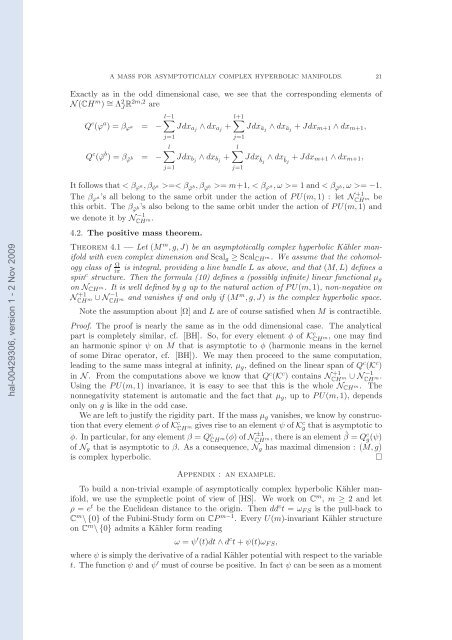

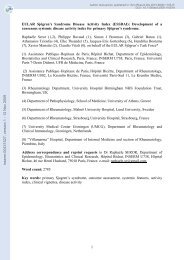
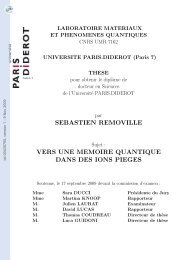
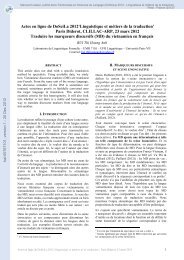
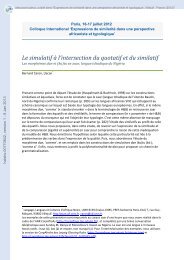
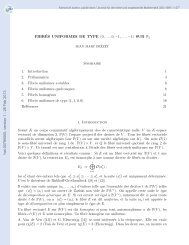
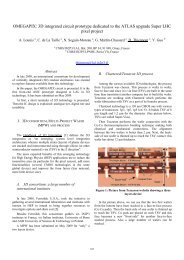
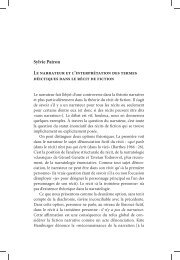
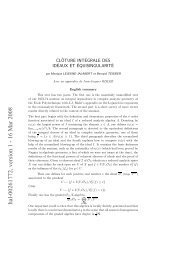
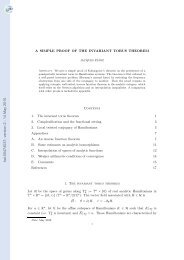

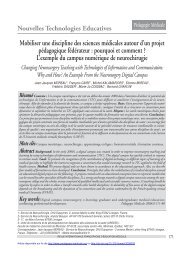

![[tel-00433556, v1] Relation entre Stress Oxydant et Homéostasie ...](https://img.yumpu.com/19233319/1/184x260/tel-00433556-v1-relation-entre-stress-oxydant-et-homeostasie-.jpg?quality=85)